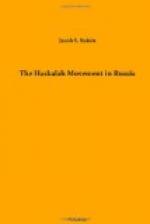(Notes, pp. 305-310.)
CHAPTER II
THE PERIOD OF TRANSITION
1648-1794
The storm of persecution that had been brewing in the sixteenth century, and which burst in all its fury by the middle of the seventeenth century, was allayed but little by the rivers of blood that streamed over the length and breadth of the Slavonic land. Half a million Jewish victims were not sufficient to satisfy the followers of a religion of love. They only whetted their insatiable appetite. The anarchy among the Gentiles increased the misery of the Jews. The towns fell into the hands of the Lithuanians, Poles, Russians, and Tatars successively, and it was upon the Jews that the hounds of war were let loose at each defeat or conquest. Determined to exterminate each other, they joined forces in exterminating the Jews. When Bratzlav, for instance, was destroyed by the Tatars, in 1479, more than four hundred of its six hundred Jewish citizens were slain. When the city was attacked by the Cossacks in 1569, the greater number of the plundered and murdered were Jews. The same happened when Chmielnicki gained the upper hand in Bratzlav in 1648, again when the Russians slaughtered all the inhabitants in 1664, and when the Tatars plotted against their victorious enemy, Peter the Great.[1] Swedish attacks without and popular uprisings within rendered the Polish pan (dubbed among Jews poriz, rowdy or ruffian) as reckless as he was irresponsible. The Jew became for him a sponge to be squeezed for money, and a clown to contribute to his brutal amusements. The subtle and baneful influence of the Jesuits succeeded, besides, in introducing religion into politics and making the Jew the scapegoat for the evils of both. The Judaeus infidelis was the target of abuse and persecution. It was only the fear that the Government’s exchequer might suffer that prevented his being turned into a veritable slave. His condition, indeed, was worse than slavery; his life was worth less than a beast’s. It was frequently taken for the mere fun of it, and with impunity. An overseer once ordered all Jewish mothers living on the estate to climb to the tree-tops and leave their little ones below. He then fired at the children, and when the women fell from the trees at the horrible sight, he presented each with a piece of money, and thanked them for the pleasure they had afforded him.[2]




